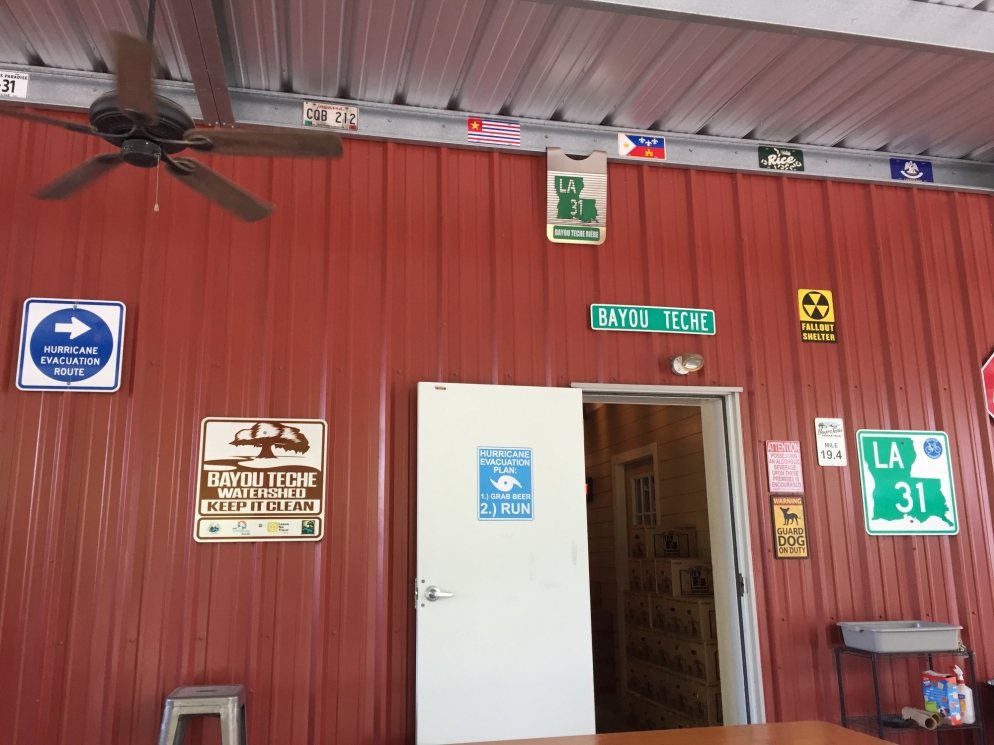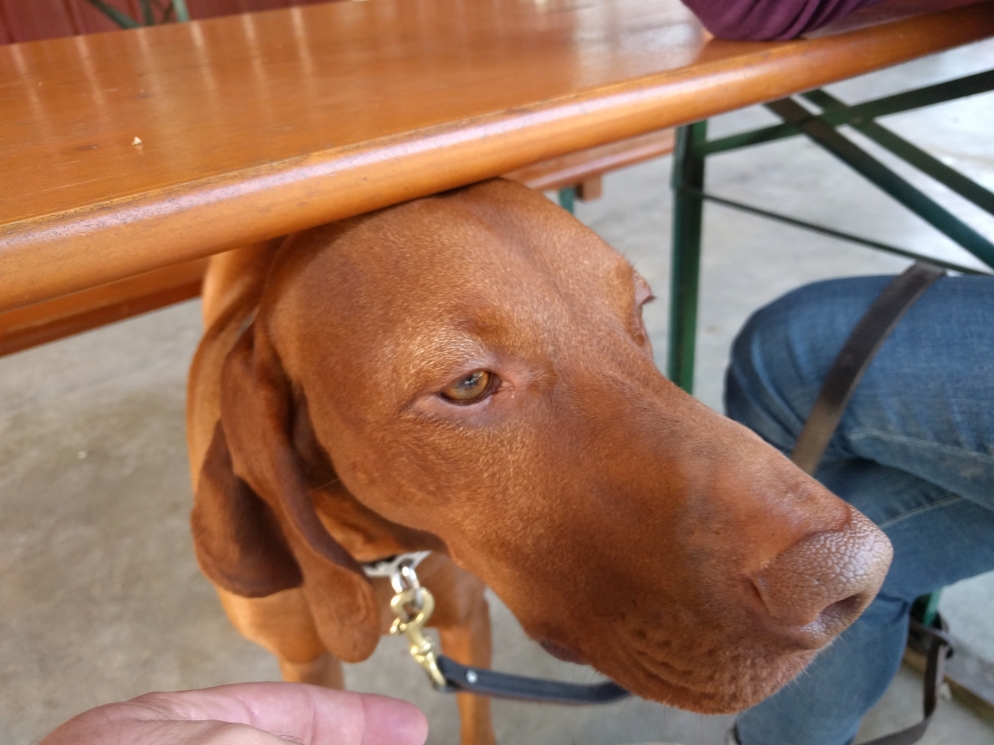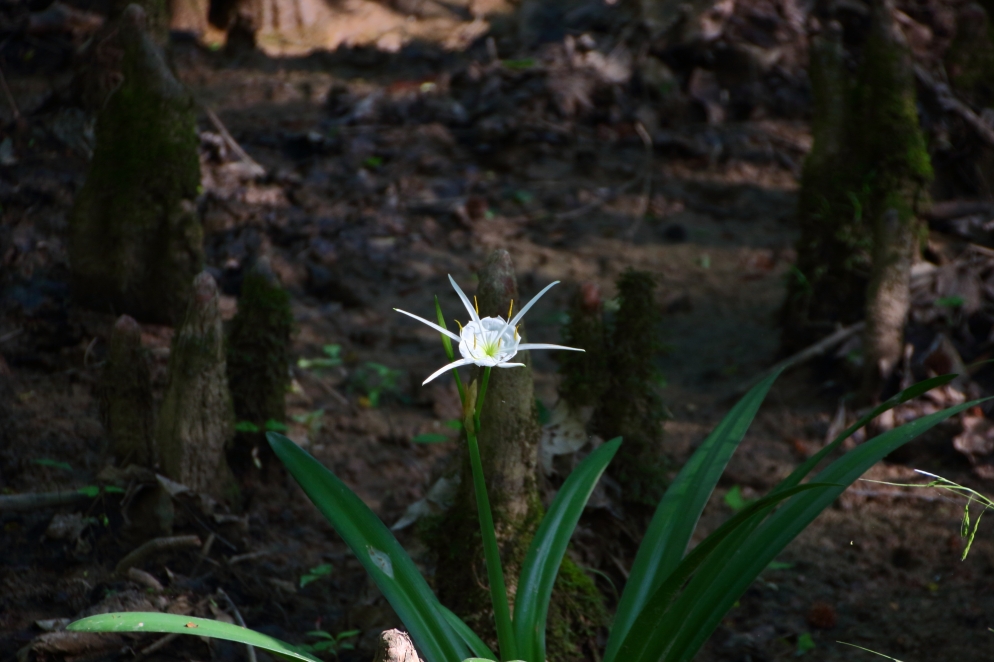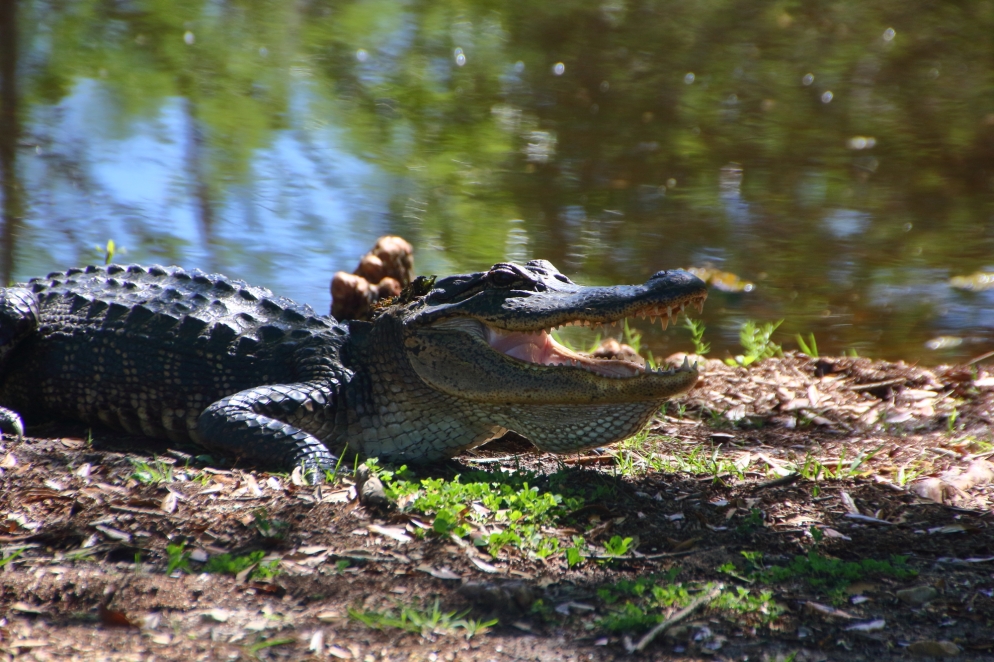April 6, 2017: In Louisiana, it’s a good idea to heed the warning signs.

On a recent afternoon we were sitting around and going through potential blog pics from our time in Louisiana to that point. One of us commented, “It’s been a busy couple of weeks,” to which the other responded, “This is only day 8.”
Here’s what’s happened so far.
Friday, March 24
On March 24, after spending time with some of our Texas and Minnesota people, we departed Blessing, Texas, heading for Louisiana. The typical Houston to New Orleans route is a 6-hour straight shot across I-10, bypassing everything along the way. But we had no particular schedule and there’s a lot of really cool stuff in between.
We departed the Interstate in East Texas and made our way down to the coast, following the Intracoastal Waterway to the east. The waterway is a pretty remarkable engineering accomplishment, providing shipping with a protected route along the coast, all the way from Brownsville, Texas, to Boston, Massachusetts. (A tour along the Waterway in a floating house might be an interesting adventure.) In this area of the world, it’s all about oil and petrochemicals, and there are some pretty big ships plying the canal.

But it’s not all oil. We decided to enter Louisiana along to coast in order to drive the Creole Nature Trail. Our first stop was the Peveto Woods Bird and Butterfly Sanctuary, where we . . . didn’t see any birds. Or take any pictures. Oh, well. Moving on, we next stopped at the Sabine National Wildlife Refuge. There the wildlife was more obvious.

Who knew that baby alligators are so cute before they get all grown up and bitey?

How many alligators can you spot in this picture?


There were birds too.

And what wetland would be complete without a snake or two?

On the boardwalk through the marsh, we encountered evidence of someone’s dinner. We assume that alligators don’t enjoy feet.


Saturday, March 25
Saturday was a whole new scene. We drove north into prairie Cajun country, where it seems the primary argicultural product these days is crawfish. The popular crustacean is grown in conjunction with rice.
Anyway, we went to Mamou, Louisiana to visit Fred’s Lounge. Fred’s is an institution, opened in 1946. The original owners are no longer around, but the Cajun music hasn’t stopped.

This bar is small. The crowd and the dancers surround the band on three sides, with everyone drinking and having a good time, including the band.

The bloodys were delicious.
Many of the folks there hit the dance floor at some point.
Did we mention that all of this gets started at 8 AM?!? Every Saturday from about 8 to 1 Fred’s hosts a band and a live radio broadcast in French and English. There were mostly locals, with a healthy smattering of tourists sticking their heads in. Some by the busload. It’s a good way to kick off your Saturday.
What does one do after Fred’s on a Saturday? We found Bayou Teche Brewing to be an excellent choice. It’s a really solid brewery, and out in the country outside Arnaudville, Louisiana. Seriously, they have crawfish ponds on the property. They had a band during the afternoon and music trivia in the evening (during which we won 2 six-packs of their beer).
Bayou Teche recently decided to join Harvest Hosts, a group of businesses like farms, vineyards, breweries, etc. that allows overnight RV parking. We met another RV-ing couple at the brewery who were there because of the HH membership. Michael talked to the brewery owners, who graciously agreed to let us park overnight in their lot. We decided to make a day of the brewery, and to join HH.

The brewery is also dog friendly, which we didn’t mind.

The fog rolled in overnight.

As you can see, our RV neighbors are having a very different RV experience. We might be able to park our house inside theirs:

Sunday, March 26
On Sunday, we headed to the 32nd Annual World Championship Crawfish Etouffee Cookoff in Eunice, Louisiana.

Teams sponsored by local businesses and institutions set up booths and sold their version of crawfish etouffee and another dish of their choice. A local hospital’s display:

Of course there was live cajun music and dancing.


This bowl of etouffee, like all the etouffee, was $3. Beers were $2, and other drinks were $1. Small town festivals have their advantages.

After all that etoufee and music, we needed a place to relax for the night. We chose Chicot State Park.

Monday, March 27
Chicot State Park is home to the Louisiana State Arboretum. We did some hiking through its trails.


There was lots of nice flora and fauna.



We even saw a wild sow and her piglets running through the woods. Unfortunately, we later learned that they were feral, not wild, and would be . . . invited to leave when park rangers caught up to them.
Wild irises were in abundance in several colors.

Another visitor had walked the trail before us:

Leaving the park, we drove to Natchitoches (pronounced Nack-o-tish, or something like that). One thing about Louisiana is that it has some of the oldest cities in the south. Natchitoches was established in 1714. It has a picturesque downtown with many original buildings along the Cane River.

Tuesday, March 28
The next day we visited the Cane River Creole National Historical Park. This park combines two plantations, the Oakland Plantation (which we visited) and the Magnolia Plantation, to present a historical view of Creole plantation life before and after the civil war. Our tour guide was a descendant of both families, and had spent time in the homes as a boy when the original families still lived in them.
So what exactly is Creole? In some circumstances, the word indicates a mixed race person, or a language of mixed origin. However, in Louisiana, Creole essentially means native born, and specifically born in colonial Louisiana. To be Creole, you must also speak French, and likely practice Catholicism. Creole was not a racial or ethnic term, and there were French, Spanish, African, and Native American (and every possible combination) Creole people in Louisiana.
Interestingly, the Cajun people are not considered Creole. We aren’t exactly sure why, but it was suggested to us that it is due to their strong self-identification forged during their long and tragic history. More on that later.
The Oakland Plantation features a number of historic buildings that have been restored to give a sense of the way the farm operated historically. There is, of course, a large plantation house, but we don’t have an outside view of the house. Sorry.




After the civil war ended slavery, the plantations had a need for labor, and the freedmen had a need for jobs, so the institution of sharecropping filled the void. Sharecropping was not as exploitative as slavery, of course, but it was still a pretty bad deal for the workers.
Lots of plantations paid their sharecroppers or contract workers with credit at the plantation store, where the sharecropper would purchase the seeds and other supplies needed to grow crops. Of course, you need to buy supplies well before you have any crop to sell, so sharecroppers were extended credit at the stores (at a cost), creating a system of debt that many families found impossible to escape. Some plantations prohibited their workers from leaving the property if they owed the plantation store money. Slavery was dead, but new system sure looked a lot like the old. Payment by company scrip wasn’t outlawed in the US until the early 20th Century, and certain industries, particularly mining, were notorious for exploiting their workers. But we digress.
While not THE Oak Alley, this is the Oakland Plantation’s alley of live oak trees:

This is the interior of the main plantation house:

Over the dining room table is a punka. A slave, usually a child, sat in the corner of the room, pulling the cord that caused this board to swing back and forth, creating some fan action.

This is the exterior of the back of the home. It is a traditional raised Creole cottage. This means that typically it is only two rooms deep with no interior hallways. It is raised, both to allow airflow underneath the home and to prevent flood damage. Most of these homes were located quite close to a river.

Wednesday, March 29
The next day we visited the small town of St. Martinville, south of I-10. It is home to the Evangeline Oak, a Cajun landmark. The Cajuns trace their history to French colonists in Acadia, now the Maritime Provinces of Canada. The Acadians lived in an egalitarian society, and, unlike most European settlers, adapted their agricultural practices to the land, and learned what they could from the local natives, with whom they intermarried. The Acadians built a prosperous and happy society.
When the British took possession of Acadia in 1710, the Acadians were allowed to keep their autonomy and their culture, and allowed to claim neutrality in any conflict between their British rulers and their French countrymen. However, during the 7 years war, the British decided they didn’t like these independent French speakers living in their territory, and expelled them from Acadia in 1755.
The expulsion was particularly brutal. Men were ordered to attend meetings and locked under guard while women and children were loaded on boats and sent off. Many families were broken up forever. Most of the Acadians were interred as prisoners in British colonies to the South. Most Acadians spent years in captivity, and many died.
Approximately 10 years after the expulsion, a group of Acadians found a home in Louisiana, which was then ruled by Spain. Having found an acceptable new home, the word went out, and dispersed Acadians began arriving from all over. (And eventually we started calling them Cajuns.)
In 1847, Henry Wadsworth Longfellow wrote an epic poem, Evangeline, about these events, centering on fictional lovers, Evangeline and Gabriel, separated by the exile. This oak symbolizes where the fictional lovers were reunited:

There is some debate over whether there was a real Evangeline and Gabriel, but their story resonates with the Cajuns nonetheless. Minneapolitans can probably appreciate the impact of a popular Longfellow poem on an area’s folklore .

St. Martinville, like much of this part of Louisiana, is not at its peak but still has some interesting historic buildings.



It’s also home to the Longfellow-Evangeline State Historic Site, which was established as Louisiana’s first state park in 1934. It was originally intended to focus solely on Acadian culture, and has this nice on-site museum that does that.

However, further research revealed that the home and sugar plantation was built by the Creole Olivier family. So now the park features both cultures. Interestingly, the Olivier family still living in St. Martinville had somehow lost the knowledge that this home originally belonged to their sugar-growing ancestors.



Live Oak trees reaching sufficient age and magnificence, such as pictured below, are given names and registered with the Louisiana Live Oak Society. (The society can only have one human member by rule, and the president of the society is a tree. Really.)





Thursday, March 30
On Thursday we took in yet more Acadian culture at the Acadian Cultural Center in Lafayette. It’s a museum which didn’t lend itself to photography. But it’s worth a stop if you’re in the area.
Friday, March 31
Our next stop was Avery Island. If you’re thinking that sounds familiar, it’s because you see those words every time you pick up a bottle of Tabasco. We toured the Tabasco factory. These are barrels of Tabasco in the making. Just add vinegar.

Tabasco pepper mash gets aged for up to three years. These salt-capped barrels look like they’ve been aging for a while. They use recycled bourbon barrels, but replace the barrel rings with stainless steel. The salt and pepper mash combination must be pretty caustic. Even the stainless rusts.

Apparently, even royals like Tabasco.

Avery Island is also home to the Jungle Gardens, created by the McIlhenny family that still privately owns and runs the Tabasco company. These gardens are clearly not at their peak, as there are not a lot of the exotic plants that were once present. But it’s still a nice manicured space.



They call this area Bird City. It’s home to the snowy white egret. Apparently the McIlhennys were instrumental in bringing this bird back from the verge of extinction by maintaining this aviary. The egrets like nesting on platforms suspended over the water. With alligators patrolling below, no predator is going to swim out and try to steal their eggs or young.






We visited Avery Island many years ago. Today, unsurprisingly, the place sees a lot more tourists. The factory tour is now self-guided, and full of interesting detail, but not as much fun as getting the personal touch. We also think the factory tour and Jungle Garden admission are a little expensive for what they are.
Avery Island is just outside of New Iberia, Louisiana. We made a stop at Bon Creole Lunch Counter. This po-boy was probably enough food for 4 people.

We had enough food at Bon Creole for a whole family, and then some other tourists came by and gave us grapefruit-sized portions of their bread pudding (with meringue on top). They apparently hadn’t realized the bread pudding they ordered came in a quarter sheet pan. Louisiana truly has an abusive love affair with food.
Saturday, April 1
Our next stop was Houma, Louisiana. It’s about as far south as you can go without a boat. It too has a historic downtown with some nice remaining buildings.

Happily we found an excellent craft beer bar called Which Craft?

Sunday, April 2
We closed out our first leg of Louisiana with a visit to the Laura Plantation. We didn’t choose it because of the name, but it was a nice bonus. It is another Creole plantation, featuring another raised Creole cottage. Much of Creole heritage and architecture came from the French Caribbean. The house is painted as it would have been originally. (look, we remembered to take a picture of the house this time!)

The family that built Laura was quite wealthy. But this home is not opulent, as it was really a place of business. We were told that each member of this family also had a French Quarter residence in New Orleans (one of which now houses world-famous restaurant Galatoire’s). They saved the opulence for the city.



Like all homes of this era, the kitchen was originally outside the home, where you see the brick foundation in this photo.

This home in ruins is the “retirement home” where one of original owners chose to live out her later years. Unlike the main house, which faces the river, this one faces the main house and the fields. She wanted to keep an eye on things, even after she handed the reins to the younger generation.

That’s what we’ve been up to for the past few days. Thanks for checking us out. Remember to click on the “follow” button if you want email reminders when we publish. And, as always, your comments are appreciated.
Now here’s some bonus music from Fred’s!
Was that a dog foot?
LikeLike
No, something smaller. Though we don’t really know what.
LikeLike
Would love to do that tour. Minus the butterfly park. Not interested. Alligators? Yes, indeed! Love you guys!
LikeLike
Great, as usual.
LikeLike